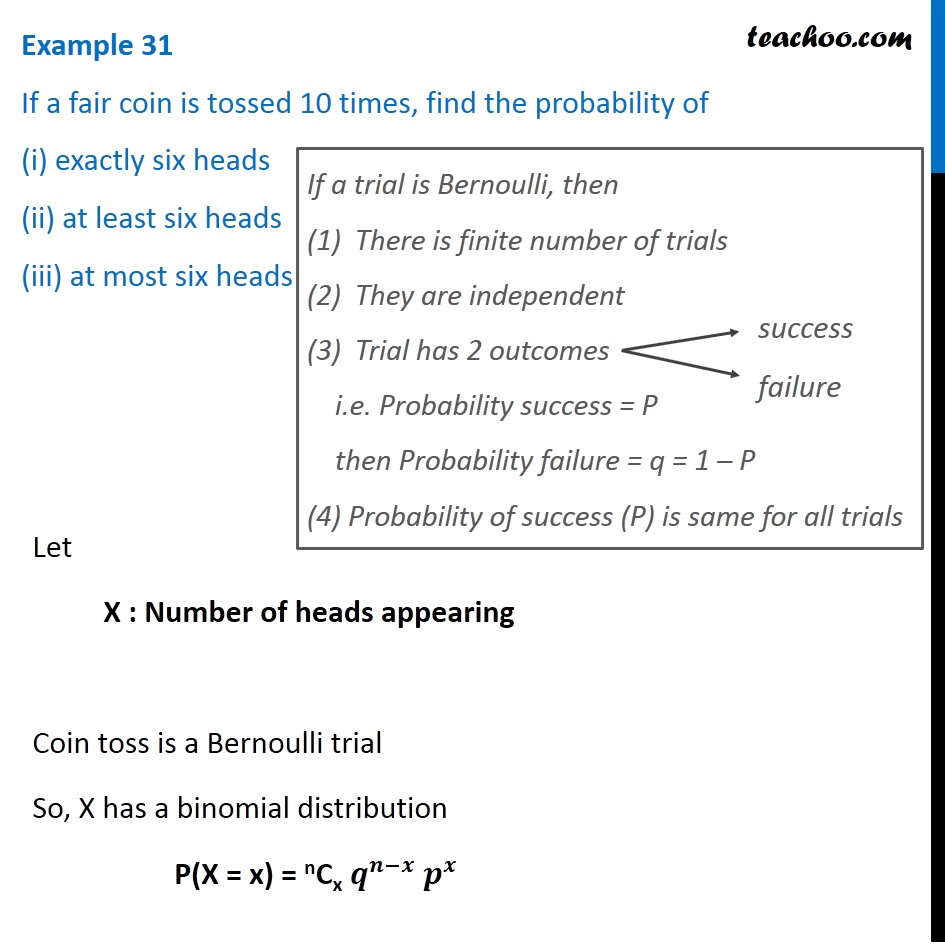




Binomial Distribution
Question 12 Deleted for CBSE Board 2024 Exams
Question 2 Deleted for CBSE Board 2024 Exams
Question 4 Important Deleted for CBSE Board 2024 Exams
Question 9 Deleted for CBSE Board 2024 Exams
Question 6 Important Deleted for CBSE Board 2024 Exams
Question 11 Deleted for CBSE Board 2024 Exams
Question 14 (MCQ) Important Deleted for CBSE Board 2024 Exams
Question 15 (MCQ) Important Deleted for CBSE Board 2024 Exams
Question 11 Important Deleted for CBSE Board 2024 Exams
Question 13 Important Deleted for CBSE Board 2024 Exams
Question 3 Important Deleted for CBSE Board 2024 Exams
Question 2 Important Deleted for CBSE Board 2024 Exams
Question 3 Important Deleted for CBSE Board 2024 Exams
Question 7 Important Deleted for CBSE Board 2024 Exams
Question 10 Important Deleted for CBSE Board 2024 Exams You are here
Question 5 Deleted for CBSE Board 2024 Exams
Question 10 Important Deleted for CBSE Board 2024 Exams You are here
Question 1 Important Deleted for CBSE Board 2024 Exams
Question 4 Deleted for CBSE Board 2024 Exams
Misc 4
Question 5 Important Deleted for CBSE Board 2024 Exams
Question 13 Deleted for CBSE Board 2024 Exams
Question 8 Deleted for CBSE Board 2024 Exams
Question 12 Deleted for CBSE Board 2024 Exams
Binomial Distribution
Last updated at April 16, 2024 by Teachoo





Question 10 If a fair coin is tossed 10 times, find the probability of (i) exactly six heads (ii) at least six heads (iii) at most six headsIf a trial is Bernoulli, then There is finite number of trials They are independent Trial has 2 outcomes i.e. Probability success = P then Probability failure = q = 1 – P (4) Probability of success (P) is same for all trials Let X : Number of heads appearing Coin toss is a Bernoulli trial So, X has a binomial distribution P(X = x) = nCx 𝒒^(𝒏−𝒙) 𝒑^𝒙 n = number of coins tosses = 10 p = Probability of head = 1/2 q = 1 – p = 1 – 1/2 = 1/2 Hence, P(X = x) = 10Cx (1/2)^𝑥 (1/2)^(10−𝑥) P(X = x) = 10Cx (1/2)^(10 − 𝑥 + 𝑥) P(X = x) = 10Cx (𝟏/𝟐)^𝟏𝟎 Probability exactly six heads Probability exactly six heads = P(X = 6) Putting x = 6 in (1) P(X = 6) = 10C6 (1/2)^10 = (10 !)/((10 − 6) ! ×6 !) × (1/2)^10= (10 !)/(4 ! × 6 !) × 1/2^10 = 105/512 (ii) Probability appearing at least six heads i.e. P(X ≥ 6) P(X ≥ 6) = P(X = 6) + P(X = 7) + P(X = 8) + P(X = 9) + P(X = 10) = 10C6 (1/2)^10 + 10C7 (1/2)^10 + 10C8 (1/2)^10 + 10C9 (1/2)^10 + 10C10 (1/2)^10 = (1/2)^10(10C6 + 10C7 + 10C8 + 10C9 + 10C10) = (1/2)^10(210 + 120 + 45 + 10 + 1) = (1/2)^10(386) = 𝟏𝟗𝟑/𝟓𝟏𝟐 (iii) Probability appearing at most six heads i.e. P(X ≤ 6) P(X ≤ 6) = P(X = 6) + P(X = 5) + P(X = 4) + P(X = 3) + P(X = 2) + P(X = 1) + P(X = 0) = 10C6 (1/2)^10 + 10C5 (1/2)^10 + 10C4 (1/2)^10 + 10C3 (1/2)^10 + 10C2 (1/2)^10 + 10C1 (1/2)^10+ 10C0 (1/2)^10 = (1/2)^10(10C6 + 10C5 + 10C4 + 10C3 + 10C2 + 10C1 + 10C0) = (1/2)^10(210 + 252 + 210 + 120 + 45 + 10 + 1) = (1/2)^10(848) = 𝟓𝟑/𝟔𝟒